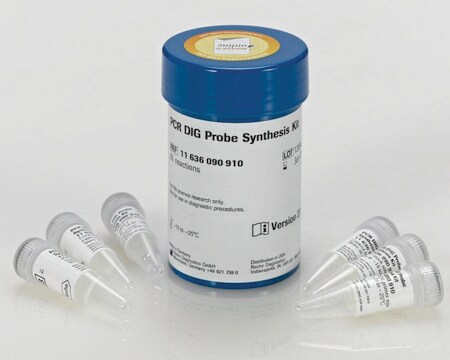Kluczowe dokumenty
11093274910
Roche
Anty-Digoxigenin-AP, fragmenty Fab
from sheep
Synonim(y):
antydigoksygenina, digoksygenina
About This Item
Polecane produkty
pochodzenie biologiczne
sheep
Poziom jakości
białko sprzężone
alkaline phosphatase conjugate
forma przeciwciała
purified immunoglobulin
rodzaj przeciwciała
primary antibodies
klon
polyclonal
Formularz
solution
opakowanie
pkg of 200 μL (150 U)
producent / nazwa handlowa
Roche
izotyp
IgG
temp. przechowywania
2-8°C
Opis ogólny
Specyficzność
Heat inactivation: yes
Zastosowanie
- cDNA array
- Colony/plaque hybridization
- Dot blot
- ELISA
- Gel shift assay
- Immunohistocytochemistry
- In situ hybridization
- Nonradioactive DNA sequencing blot
- Northern blot
- RNase protection assay
- Southern blot
- Western blot
- Fluorescent in situ hybridization
- Section in situ hybridization and whole mount in situ hybridization
- Electrophoretic mobility shift assay
Uwaga dotycząca przygotowania
Working concentration: Working concentration of conjugate will depend on the application and substrate. The following concentrations should be taken as a guideline:
- Dot blot: 150 mU/ml
- ELISA: 150 to 300 mU/ml
- Immunohistocytochemistry: 250 to 500 mU/ml
- In situ hybridization: 1.5 to 7.5 U/ml
- Southern blot: 150 mU/ml
- Western blot: 250 to 500 mU/ml
Working solution: Northern blot, Southern blot
100 mM Maleic acid, 150 mM NaCl, pH 7.5.
Western blot
50 mM Tris-HCl, 150 mM NaCl, pH 7.5
other applications
100 mM Tris-HCl, 150 mM NaCl, pH 7.5
1% Blocking reagent (w/v), 1 to 5% heat inactivated fetal calf serum (v/v) or sheep normal serum can be used for reduction of unspecific binding.
Storage conditions (working solution): Diluted conjugate is stable at 2 to 8 °C for 12 hours.
Always prepare freshly!
Komentarz do analizy
- Cross reactivity to digitoxin and digitoxigenin: <1 %
- No cross reactivity with other human estrogen or androgen steroids, e.g. estradiol or testosterone
- Cross reactivity with digoxin: not known
- Conjugate does not bind to itself at all
- Normally one molecule of the conjugate binds to one molecule digoxigenin, although ther are two possible binding sites for digoxigenin
- Nonspecific binding to RNA is not expected
Inne uwagi
Nie możesz znaleźć właściwego produktu?
Wypróbuj nasz Narzędzie selektora produktów.
Klasa zagrożenia wodnego (WGK)
WGK 1
Temperatura zapłonu (°F)
No data available
Temperatura zapłonu (°C)
No data available
Wybierz jedną z najnowszych wersji:
Masz już ten produkt?
Dokumenty związane z niedawno zakupionymi produktami zostały zamieszczone w Bibliotece dokumentów.
Klienci oglądali również te produkty
Produkty
Digoxigenin (DIG) labeling methods and kits for DNA and RNA DIG probes, random primed DNA labeling, nick translation labeling, 5’ and 3’ oligonucleotide end-labeling.
Metody znakowania digoksygeniną (DIG) i zestawy do sond DNA i RNA DIG, znakowanie DNA z losowym primerem, znakowanie nickiem translacyjnym, znakowanie końcowe oligonukleotydów 5' i 3'.
Nasz zespół naukowców ma doświadczenie we wszystkich obszarach badań, w tym w naukach przyrodniczych, materiałoznawstwie, syntezie chemicznej, chromatografii, analityce i wielu innych dziedzinach.
Skontaktuj się z zespołem ds. pomocy technicznej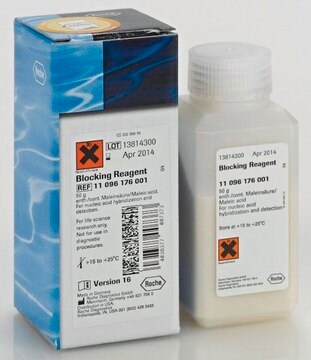

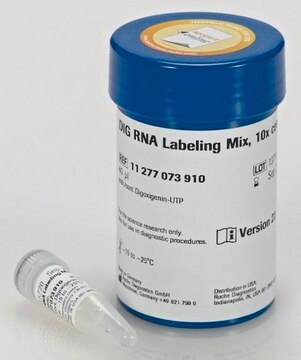

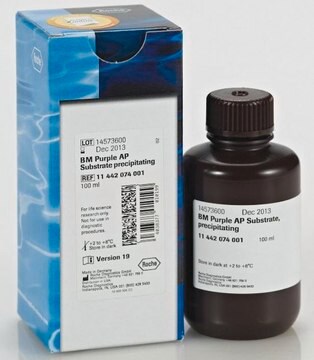
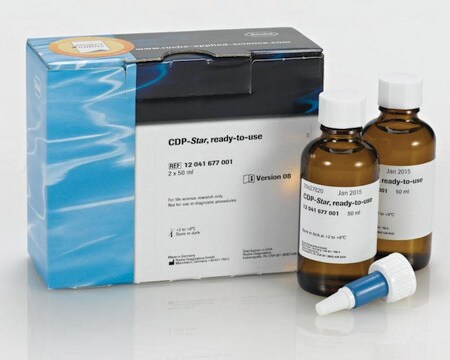
![CDP-Star® Disodium 2-chloro-5-(4-methoxyspiro {1,2-dioxetane-3,2′-(5′-chloro)tricyclo[3.3.1.13,7 ]decan}-4-yl)-1-phenyl phosphate](/deepweb/assets/sigmaaldrich/product/structures/224/846/d08963f5-c8ba-42e6-b4f7-9ee7fd76d809/640/d08963f5-c8ba-42e6-b4f7-9ee7fd76d809.png)
